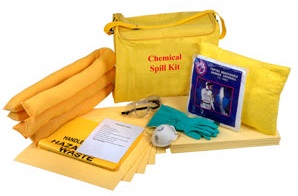 |
So, should you wash, dry, or toss your solvent-contaminated rags?
How About Dry?
We can tell you right away, don’t hang your solvent-contaminated wipes out to dry. Let’s take that one off the table. Never mind the Resource Conservation and Recovery Act (RCRA) violations you would be facing, you will also have great big headaches under the Clean Air Act (CAA) as those solvent vapors waft into the air.
RCRA provides an all-encompassing definition of hazardous waste treatment that applies to hundreds of treatment methods and technologies. “Hazardous waste treatment” is defined as “any method, technique, or process, including neutralization, designed to change the physical, chemical, or biological character or composition of hazardous waste” (423 USC 6903(34)).
Evaporation, in some cases, is an allowable treatment, but to treat hazardous waste, you would need a treatment, storage, and disposal facility (TSDF) permit. So, if you want to avoid becoming a TSDF, don’t hang your wipes out to dry!
Join us for the Solvent-Contaminated Wipes webinar on June 23 to recognize what’s considered a “wipe” under the EPA’s regulations. Learn more.
How About Toss?
Now’s the time to consider the Solvent-Contaminated Wipes final rule’s hazardous waste exclusion if you want to toss your solvent-contaminated wipes. The first thing you have to do is determine if they are a solid waste. Well, they are wipes (i.e., woven or nonwoven shop towel, rag, pad, or swab made of wood pulp, fabric, cotton, polyester blends, or other material)—sounds like a solid, and you are throwing them out—technically, under RCRA, you are “abandoning” them by “disposing of” them. Sure looks like they’re solid waste.
Next, you have to determine if they are hazardous waste. First, you check to see if the solvent used is a listed waste. The EPA has applied the listing criteria to hundreds of specific industrial wastestreams. Check to see if your solvent is one or more of the F001 through F005 solvents listed in 40 CFR 261.31 or one of the corresponding P- or U-listed solvents found in 40 CFR 261.33.
Then you must check to see if the waste has a hazardous characteristic. The hazardous characteristics are reactivity, corrosivity, ignitability, and toxicity. You must check for hazardous characteristics even if the solvent used is a listed waste.
So, if you go through the determination process and figure out that the wipes are a solid or hazardous waste and you decide to toss them, you can’t just throw them in the trash. If the wipe is hazardous, you must contract with a hazardous waste transporter and a TSDF (and comply with other hazardous waste storage requirements before you send them off). Make sure you don’t treat the wipes yourself unless you want to become a TSDF.
But, here is where the federal rule provides you with some flexibility. Solvent-contaminated wipes that are determined to be hazardous are exempt from the definition of hazardous waste (and, therefore, can be tossed out) provided certain conditions are met concerning container management, a time limit, free liquids, recordkeeping, and the disposal facility to which the wipes are sent. We’ll talk about these conditions tomorrow.
The key here is the solvent. If, after you use the wipe, it contains an F001- to F005-listed solvent or its corresponding P- or U-listed solvent, it may be eligible for the exclusion from the definition of hazardous waste. In addition, if the wipe exhibits a hazardous characteristic resulting from the solvent used being listed or if the wipe exhibits only the hazardous ignitability characteristic because of solvents that are not listed wastes, your wipes may be eligible for the exemption. Just make sure that there are no free liquids in the wipes themselves or in the container holding them.
Solvent-Contaminated Wipes: Best Practices for Determining Exemption Eligibility and Meeting Regulatory Requirements
Learn how facilities must manage the wipes as specified in the regulation and comply with applicable recordkeeping requirements. Register now!
What About Wash?
Again, here’s where the federal Solvent-Contaminated Wipes final rule provides you with some flexibility in managing your solvent-contaminated wipes. Under the rule’s solid waste exclusion, solvent-contaminated wipes sent for cleaning and reuse are exempt from being solid wastes provided certain conditions are met concerning container management, a time limit, free liquids, recordkeeping, and the laundry or dry-cleaning facility to which the wipes are sent. These conditions will be explained tomorrow.
